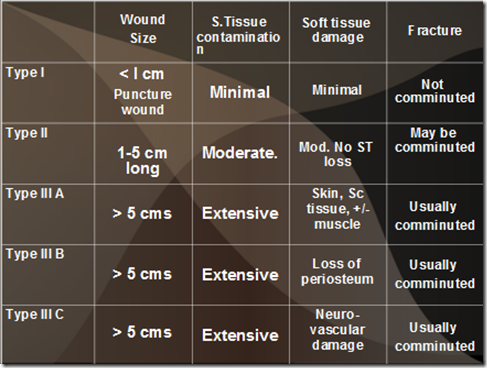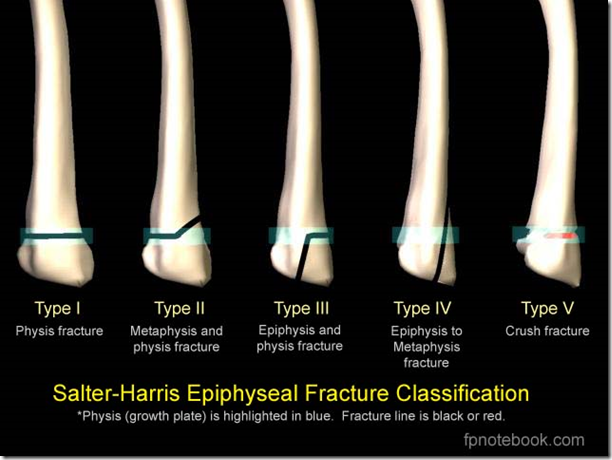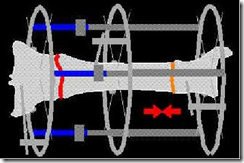Definition:
Complete or incomplete break in the structural continuity of a bone.
Type of fractures:
1) Close (simple)
- Best treated with closed method
- unless there is indication to use open method
- once opened there are risks of infection
2) Open (compound)
- Definition: Fractures communicating outside through a rent in the skin
- Fracture with lacerated wound
- More common in subcutaneous bone
- subcutaneous bone – tibia
- Gustilo classification
- Type 1
- wound small < 1cm long
- little soft tissue damage
- minimal contamination
- fracture not comminuted
- crushed or splintered bone
- Type 2
- wound 1-5cm long
- soft tissue damage
- moderate contamination
- fracture may be comminuted
- Type 3
- extensive damage to skin
- soft tissue & neurovascular damage
- contaminated
- fracture comminuted
- Sub-classification
- Type 3a
- loss of skin and muscles
- Type 3b
- loss of periosteum
- Type 3c
- associated neuro-vascular injury
- Complications
- Bleeding
- Infection
- Chronic osteomyelitis
- Delayed union
- Non-union
- Joint stiffness
- Restriction
- Muscle fibrosis
3) Pathological fracture
4) Stress fracture
Displacement of fracture:
- fragments may be
- displaced, due to
- muscle spasm
- gravity
- tilted/angulated
- twisted/rotated
- overlapped/lengthened
- displaced, due to
Clinical features
- History
- Mechanism of fracture
- twisting
- bending
- compression
- combination of forces
- avulsion
- traction
- flexion
- extension
- Pain
- Swelling
- Tenderness
- Deformity
- Abnormal mobility
- Loss of function
Union of fractures
- Blount’s law
- Fractures in children unite faster
- Fractures closer to the joints unite faster
- Displacements at the fracture will remodel
- Angulations in the plane of movement of the joint < 20 degrees are acceptable
- Rotations will never remodel
- Intra-articular fractures
- The break crosses into the surface of a joint
- They always result in some degree of cartilage damage
- Reduced anatomically
- the joint surfaces should be restored to their original position and held there strongly enough that movement may be started in the early postoperative period
- However, a step of more than 2mm is not acceptable
When a patient is brought into the A&E with a fracture..
- ABCD
- airway
- breathing
- circulation
- deformity
- 4 questions to ask (to classify fracture)
- Nature of the wound
- State of skin around the wound and bone
- Is circulation intact?
- Are nerves intact?
- Splint the fracture
- treat life threatening injuries 1st
- Reduce the fracture
- Closed method
- Anaesthesize/Sedate
- Traction
- counter traction
- skin traction
- skeletal traction
- straighten broken bones
- Once the fracture fragments disengage, reduction is attempted
- Immobilisation of fracture
- External
- Continuous traction
- skin / skeletal
- Plaster of paris cast
- Functional bracing
- External fixation
- Internal
- Plates & Screws
- Intramedullary nails
- Interlocking nails
- K-wire
- Check neurovascular
- Open method
- This method used when
- When closed method fails, due to
- soft tissue interpositioned
- difficulty in controlling the fragments
- Intra-articular fractures
- Avulsion fractures
- patella & olecrenon fractures
- Unstable fractures
- Multiple fractures
- head & spinal injury
- Uncooperative patients with vascular injury
- Immobilize the fracture
- Treat systemic disorders
Healing of fractures (Stages)
- Haematoma formation
- Tearing of:
- endosteal vessels
- haematoma around the fracture site
- periosteal arteries
- bone in the immediate vicinity of the fracture dies & undergoes necrosis
- Subperiosteal & endosteal cellular proliferation
- Cells from deep layer of the periosteum & medullary canal proliferate
- form osteoblasts
- lays down intercellular substance
- Haematoma gets pushed aside by the proliferating cells & gets resorbed
- Soft callus formation (woven bone)
- 6-8 weeks
- Cellular tissue from both ends differentiate into osteoblasts and chondroblasts
- Formation of Intercellular martix (collagen & polysaccharides) with calcium salts
- Provides stability to the fracture
- felt as hard mass around the fracture
- Xray – 1st sign of fracture union
- Consolidation of callus
- 12-18 weeks
- Soft callus + osteoblastic activity
- mature bone
- has a lamellar structure
- Remodeling
- 1-2 yrs
- depends on the lines of stress
- Forms a bulbous swelling around the fracture
- Closes the medullary canal
Epiphyseal injury (involving the epiphyseal plate)
Salter-Harris classification
_____________________________________________________________________
Fracture complications
Early complication
- Hypovolaemic shock
- Neurological
- Vascular
- Compartment syndrome
- Crush syndrome
- Deep vein thrombosis
- Infection
- Gangrene
- Tetanus
- Visceral injury
- Urethra
- Bladder
- Lung
Late complication
- Mal-union
- Non-union
- Joint stiffness
- Re-fracture
- Arthritis
- Necrosis
- Osteopenic
- Reflex sympathetic dystrophy
- Muscle contracture
- fibrosis
Dislocation complications
- Vascular
- Neural
- Avascular necrosis
- Recurrent dislocation
- Traumatic arthritis
- Heterotopic ossification
- process by which bone tissue forms outside of the skeleton
- Unstable joint
_____________________________________________________________________
Management of fractures
Factors in bone healing
1. Age.
2. Vascularity.
3. Anatomical Reduction.
4. Stability.
5. Nutrition.
6. Co-morbidity.
7. Medication.
8. Smoking.
9. Infection.
10. Type of Fractures.
Investigation
- X-ray
- AP
- Lateral
- Special
- 2 joints
- 2 times
- 2 limbs
- CT
- 3D reconstruction
- MRI
- Angiogram
- Bone scan
Fracture management depends on:
- Closed / open fracture
- Age of patient
- Intra-articular fracture
- Site of fracture
- Presence of associated injuries
- Systemic disorders
What is the ‘golden period’ ?
- The 1st 6 hours after fracture
- better results
- non-infected
- Aim:
- Wound debridement (Stages)
- Irrigation with saline
- H2O2 (Hydrogen peroxide)
- Antibiotics
- Exploration
- Culture sample
- before and after
- Removal of foreign materials
- Tissue debridement (removal of dead tissues)
- Blood vessels
- Nerves
- Tendon
- Fascia
- Joint closure
- Plastic surgery procedures
- Skin graft
- Flap
- Free flap
- Rotation
- External fixation
- Dressing
- Drain
- Immobilisation
- tetanus toxoid injection
- antibiotics administration
- Broad spectrum
- Gram +/-
- Aerobic/anaerobic
- Keep limb elevated
- Observation
- neurovascular
- Continue antibiotic prophylaxis
- Re-debridement necessary
- Drainage removal
- Limit mobilisation
- to prevent complications
_____________________________________________________________________
OLIS
- Clinical aspects of fracture
- Fracture healing
- Behavioural issues in long bone fracture





itz awesome impressive lecture notes